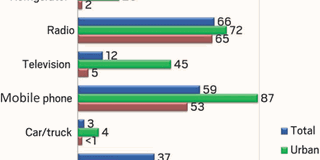Poverty gap widens further

Household goods used to measure poverty in %
Although the number of richer Ugandan has improved substantially over the years, a recent survey reveals a huge contrast in the rate of wealth between people living in urban areas and those in rural areas.
The 2011 Uganda Demographic and Health survey conducted by the Uganda National Bureau of Statistics (Ubos ) indicates that three-quarters of the population (75 per cent) is the highest wealth quintile, compared to rural areas where only one in every nine people (11 per cent) are in the richest category.
The survey was conducted in 10 districts including West Nile, North, Karamoja, Eastern, East Central, Central1, Central2, Western, South West, and Kampala. The report further shows that wealth distribution also varies greatly across regions, with over 90 per cent of the population in Kampala being the highest wealth quintile, while in other regions the proportion is 35 per cent or lower.
In Karamoja, eight in 10 households are in the lowest quintile while 33 per cent of the population in the North, West Nile, and Eastern regions is in the lowest quintile, indicating that poverty is more concentrated in the northern region.
Mr Andrew Mukulu, the director population and social statistics at Ubos, however, said the Karamoja region could have been ranked as the region with the largest proportion of poorest households due to the fact that they don’t own a set of goods that were used in wealth index. “The Karamajongs own cattle and could be rich because they own cattle but we didn’t use cattle to measure; maybe that’s why they fall in that category,” Mr Mukulu said.
According to the report, wealth is determined by a set of characteristics like access to electricity and ownership of various consumer goods including the use of refrigeration, radio, television, mobile phones, motor vehicle and bicycles among others. Access to electricity in the country is said to have increased slightly by 6 per cent from 2006 to 15 per cent in 2011.
The number, however, grew faster in urban areas from 42 per cent to 55 per cent over the period while in rural areas the number of people with access to power rose from 3 in 2006 to 5 per cent in 2011.
Prof Augustus Nuwagaba, a poverty eradication consultant and an Economist said there is need to commercialise agriculture and promote urbanisation to reduce the huge gap between the rich and poor in rural and urban areas.
A big population of rural Uganda is involved in substance farming due to limited access to modern farming tools, limited access to agricultural finance and a rigid land tenure system, which Prof Nuwagaba said must be addressed. The low electricity consumption is hinged on the to high tariffs and low industrialisation in the country.
The Uganda national vision 2040, however, targets to have at least 80 per cent of Ugandans to have electricity by 2040 and to increase electricity consumption per capita (kWh) from 75 to 3,668 through industrialisation.




